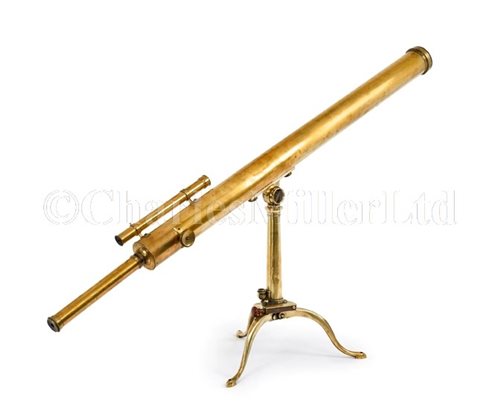30th Apr, 2014 12:00
Maritime and Scientific Models, Instruments & Art (Seraph)
65
[M] AN HISTORICALLY INTERESTING EARLY 19TH-CENTURY...
signed on the back-plate Thos. Jones Charring Crofs, with 2½in. objective lens, 42in. lacquered-brass main tube inscribed Thomas Graves R.N., eyepiece with rack-and-pinion focus, interchangeable tubes with astronomical shade accessories, dew cuff, tripod stand with endless tangent screw circumferential adjustment, contained within original fitted case with substantial carrying handles to ends and lid, overall measurements -- 5¾ x 45½ x 9½in. (14.5 x 115.5 x 24cm.)
An apprentice, then employee of Jesse Ramsden,Thomas Jones moved to his Charing Cross premises (No.62) in 1816 and remained there until 1850. He was also telescope maker by Appointment to the Duke of Clarence, later William IV. From 1831 he was signing his instruments 'Jones & Sons' when his son, also Thomas, joined the business, indicating that this lot was sold between 1816 and 1830 - precisely when Graves would have been looking for a good quality and versatile instrument for his work.
Capt. Thomas Graves (1804-1856) entered the navy in 1816, obtained his first commission on 30th April 1827 and joined the survey ship H.M.S. Adventure under Captain Philip Parker King, that August bound for South America. A talented seaman as well as naturalist, five years later he had risen sufficiently to be given his own command (first the Mastiff; then Meteor and Beacon) and spent the rest of his career surveying the Mediterranean. In 1846 he joined the Ceylon at Malta and advanced to the rank of Captain where he assembled a formidable team of scientists around him including Edward Forbes, Professor of Natural History at Edinburgh University. They completed surveys at up to 230 fathoms - the deepest undertaken at the time, and also conveyed to England a collection of carved and inscribed ancient marbles recovered from the ruins of Xanthus by Sir Charles Fellows. In 1853 Graves was made Superintendent of the Ports at Malta, however it seems he had some altercation with a local boatman that left him so incapacitated he was placed on half pay and died of his wounds on 28th August 1856 - whilst the boatman was tried for murder, the navy lost one of its most talented surveyors. His name however lives on in several species named in his honour, including Pompilus gravesi and Cascellius gravesi.
Sold for £2,232
Estimated at £1,800 - £2,500
(inc. buyer's premium of 24%)
Condition Report
Optics appear complete and in good, clear condition - all the accessories also seem to be located. The tube has the usual rubs and wear commensurate with use, but lacks the telescopic steadying rods it once had - the location lugs are there for them.
We are pleased to provide you with a general report of the condition of this property. Since we are not professional conservators or restorers, we urge you to consult with a restorer or conservator of your choice who will be better able to provide a detailed, professional report. Prospective buyers should inspect each lot to satisfy themselves as to condition and must understand that any statement made by Charles Miller Ltd is merely a subjective, qualified opinion. Prospective buyers should also refer to any Important Notices regarding this sale, which are printed in the Sale Catalogue. NOTWITHSTANDING THIS REPORT OR ANY DISCUSSIONS CONCERNING A LOT, ALL LOTS ARE OFFERED AND SOLD “AS IS” IN ACCORDANCE WITH THE CONDITIONS OF BUSINESS PRINTED IN THE SALE CATALOGUE.
signed on the back-plate Thos. Jones Charring Crofs, with 2½in. objective lens, 42in. lacquered-brass main tube inscribed Thomas Graves R.N., eyepiece with rack-and-pinion focus, interchangeable tubes with astronomical shade accessories, dew cuff, tripod stand with endless tangent screw circumferential adjustment, contained within original fitted case with substantial carrying handles to ends and lid, overall measurements -- 5¾ x 45½ x 9½in. (14.5 x 115.5 x 24cm.)
An apprentice, then employee of Jesse Ramsden,Thomas Jones moved to his Charing Cross premises (No.62) in 1816 and remained there until 1850. He was also telescope maker by Appointment to the Duke of Clarence, later William IV. From 1831 he was signing his instruments 'Jones & Sons' when his son, also Thomas, joined the business, indicating that this lot was sold between 1816 and 1830 - precisely when Graves would have been looking for a good quality and versatile instrument for his work.
Capt. Thomas Graves (1804-1856) entered the navy in 1816, obtained his first commission on 30th April 1827 and joined the survey ship H.M.S. Adventure under Captain Philip Parker King, that August bound for South America. A talented seaman as well as naturalist, five years later he had risen sufficiently to be given his own command (first the Mastiff; then Meteor and Beacon) and spent the rest of his career surveying the Mediterranean. In 1846 he joined the Ceylon at Malta and advanced to the rank of Captain where he assembled a formidable team of scientists around him including Edward Forbes, Professor of Natural History at Edinburgh University. They completed surveys at up to 230 fathoms - the deepest undertaken at the time, and also conveyed to England a collection of carved and inscribed ancient marbles recovered from the ruins of Xanthus by Sir Charles Fellows. In 1853 Graves was made Superintendent of the Ports at Malta, however it seems he had some altercation with a local boatman that left him so incapacitated he was placed on half pay and died of his wounds on 28th August 1856 - whilst the boatman was tried for murder, the navy lost one of its most talented surveyors. His name however lives on in several species named in his honour, including Pompilus gravesi and Cascellius gravesi.
Auction: Maritime and Scientific Models, Instruments & Art (Seraph), 30th Apr, 2014



